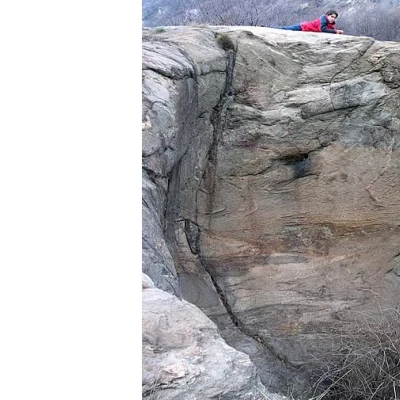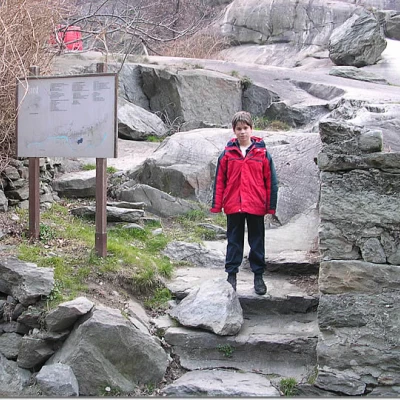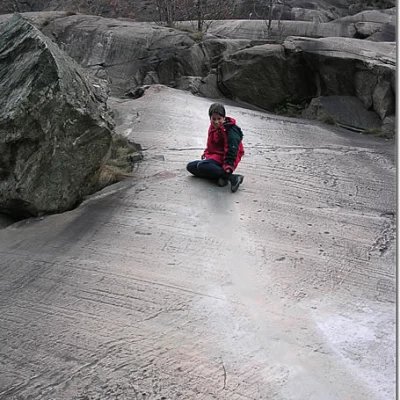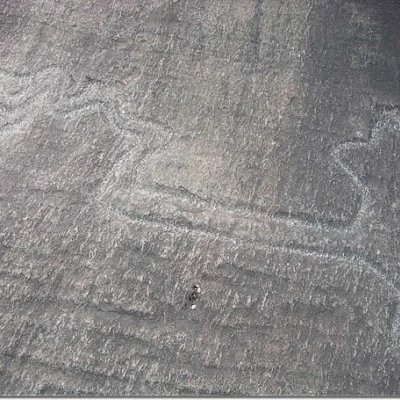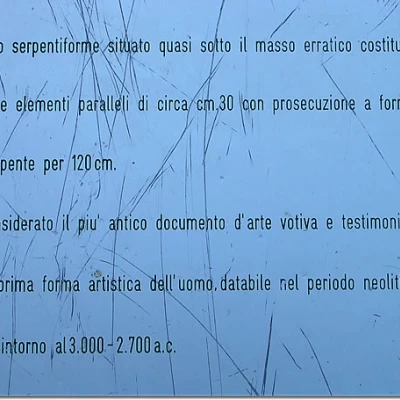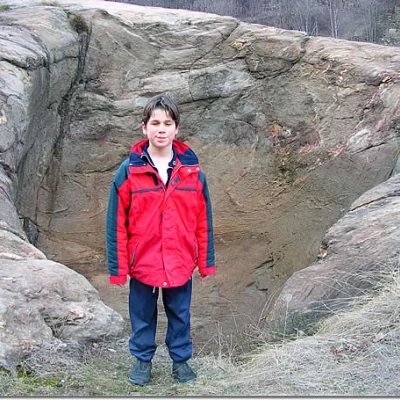Muffler of Giants
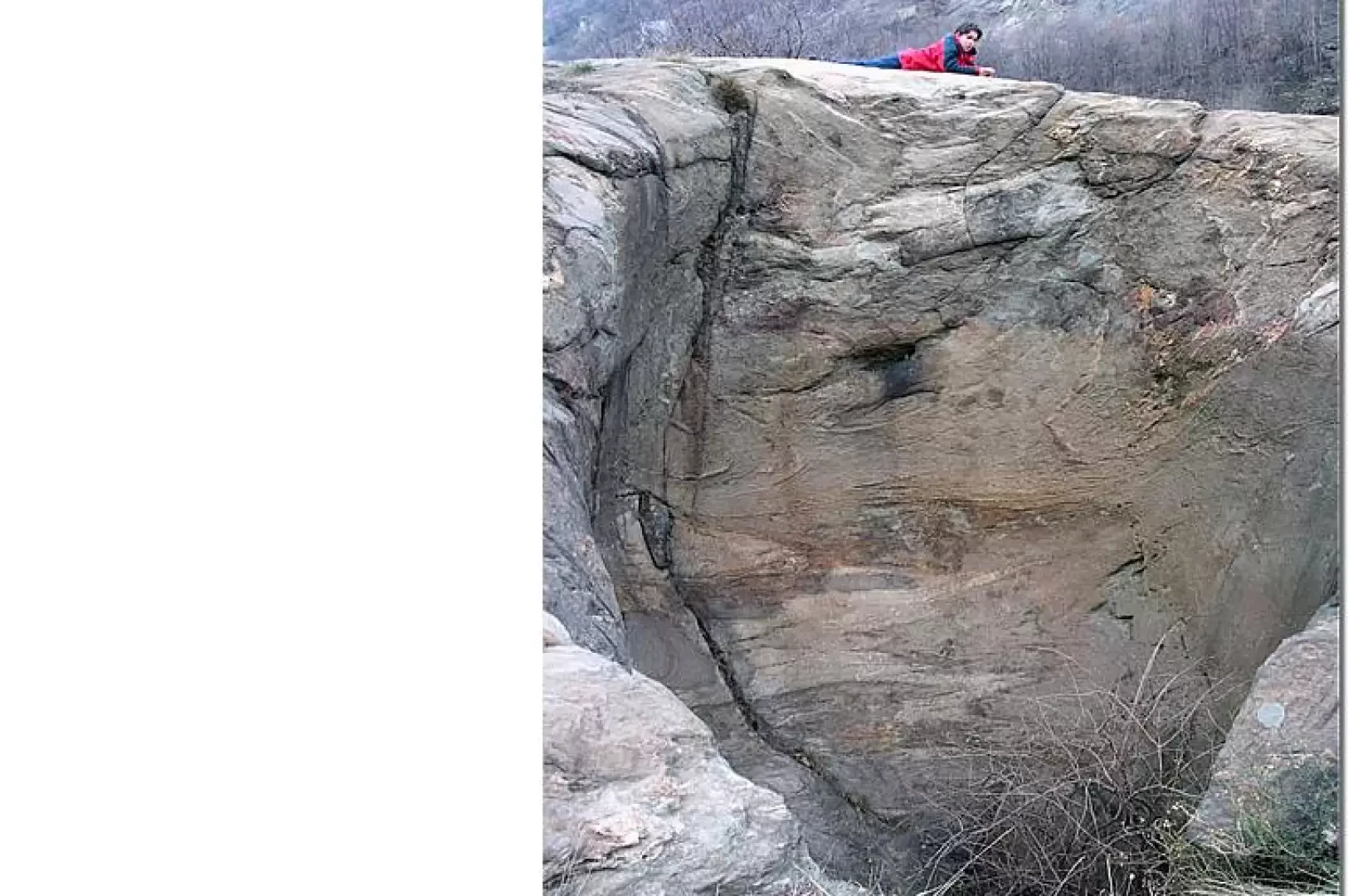
Introduction
The Marmitta dei giganti di Bard is one of the many geosites in Valle d'Aosta. Those who wish to learn more about the origin and peculiarities of this geological curiosity can consult the relative file on the region's website, which is full of scientific and cartographic information.
Description
After parking the car, you retrace your steps until you reach the beginning of the route leading to the pothole. You climb a few steps and a few metres away is an erratic boulder left by the retreating Baltese glacier some 10,000 years ago. At its foot is a rock carving believed by some scholars to date back to the 3rd millennium BC, and to its right is the slide used for pleasure by generations of children and renamed the women's slide because by some scholars it is linked to fertility rites of distant origin. As a curiosity, I would like to point out the presence of other rock engravings of clear contemporary origin to the right of the said chute. We continue up the mountainous slope for a few dozen steps until we reach a narrow track that goes away on the level towards Donnas. Following it towards the end of the cliff, you soon reach the pothole, which is located a few metres from the edge of the precipice. Its diameter is about five metres and the maximum depth is seven. It was carved by the swirling waters that descended from the two edges of the Bard glacier that were once divided by the rocky ridge where the present Fortress of Bard stands. The siege of Fortress of Bard in 1800 by Napoleon's troops has left a deep mark on the collective memory and sometimes the tales of those epic days are exaggerated and misrepresented. Thanks to the accurate work of Mr. Alfonso Bernardi and his collection of period documents, a copy of which has been deposited at the regional historical archive in Aosta, it is possible to faithfully reconstruct those events. I have used part of his documentation to draw up a short chronicle. 15 May 1800 the vanguard of the reserve army entered the Aosta Valley and stopped at Etroubles after having crossed the Great St. Bernard Pass 16 May Aosta was conquered 18 May Ch â tillon fell 19 May in the morning the vanguard arrived in sight of the Bard fort, 20 May the commander of the army wrote to Napoleon: 'it is impossible to let the artillery pass until we have conquered the castle of Bard ... the infantry and cavalry can bypass the castle by taking a mule track that goes from Arnaz to Perlo ... the route around the castle is very difficult, even for the infantry. However, I venture to get two regiments of mounted troops of the vanguard "21 May" to pass you, the vanguard is at Pont Saint Martin and Carema ... Tomorrow, before daylight, I will attempt a full-scale attack; I have had ladders prepared... if we do not manage to open the passage, we will have to lay siege to it" 22 May, "the village of Bard falls and the garrison retreats to the fort. The inhabitants had long since fled to the mountains. At the gate towards Donnas, two French officers were wounded by friendly fire as they reached their comrades. In the confusion of the battle they had been mistaken for defenders of the fort who were attempting a sortie. 22 May "the 4-piece and the howitzer failed to pass, the enemy did not cease for a moment the lively artillery fire on the road (that crosses the village) out of thirteen men who tried to pass one was killed and seven wounded". 22 May Ivrea is conquered 24 May during the night two 4-pieces manage to pass but the two 8-pieces that follow them are destroyed by the fort's artillery 25 May Napoleon inspects the new path that allows you to bypass the fort and reach Donnas in two and a half hours of march, noting that it is impossible for artillery to pass. During the night, the commander of the artillery, General Marmont, orders the wagon wheels, chains and anything else that can make noise to be wrapped in twisted hay, has the litter and mattresses still in the houses spread on the pavement, then unhitched the horses and had his men pull the artillery in perfect silence. Covered by the noise of the swirling waters of the Dora and a storm that broke out around midnight, they managed to get four pieces of eight through, then the alarm was sounded and under a rain of fire they still managed to get two cannons through, then the column stopped. Thanks to the stratagem, only 6 of the 40 cannons of the army passed through. 26 May an attack on the fort from three directions is attempted but is repulsed. The raft used to cross the Dora was sunk 1 June Final assault on the fort led by General Chabran commander of the rearguard. General Andreossi, commander of the artillery, had a 12-piece placed in the presbytery of the parish church, next to the bell tower, and from there, protected by the overhanging rock face, he began to cannonade the entrance gate to the fort, which was about 150 m away. The defenders can do nothing against that cannon, which from 9 a.m. begins the systematic demolition of the defences. At sunset, the surrender is announced for the fifth time, and the commander of the fort, the then Captain Joseph Otto Stockard von Bernkopf, signs it, with the honour of arms, at nine o'clock in the evening. The fort that stopped Napoleon's artillery for 14 days was completely razed to the ground at the end of hostilities and nothing remains of it. Today's formidable architecture was built from 1830 to 1838 and never took part in warlike events. Bibliography
- Bernardi Alfonso, Le Siège de Bard en 1800, published by the author
